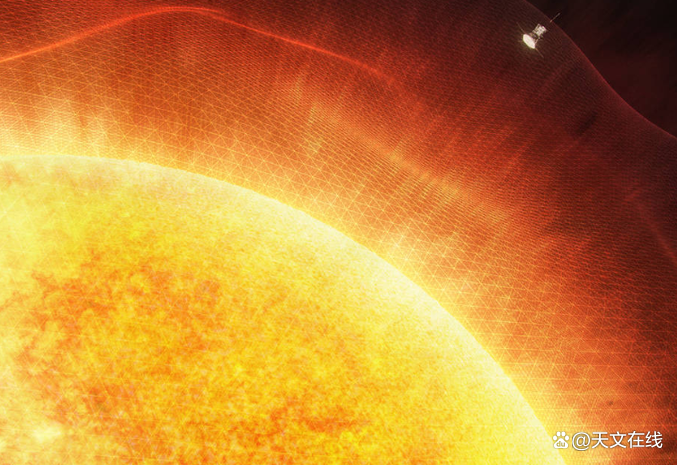Simten to plasma waves, peek into the sun, understand the solar structure
Author:Astronomy online Time:2022.09.12
The slow wave found on the sun can pull away the fog of the sun magnetic field
40 years ago, the existence of this long cycle has been predicted.

(Graphic: The long -term plasma wave found on the surface of the sun originated from the depth of its surface. Source: MPS)
For the first time in history, scientists have found huge plasma slowly on the surface of the sun, which can help us explain the mystery hidden behind this star magnetic field.

(Illustration: ESA/NASA solar track vehicle one of the first images taken by the first batch of images during the first time in 2020. Source: space.com)
Researchers from the Institute of Max Planck's Institute of Planck in Germany and researchers at the University of Gosteen in Germany checked the data obtained by the NASA Sun Dynamics Observatory in the past ten years and found that the movement speed of the plasma vortex on the surface of the solar surface is only 3 mm (5km/ h), this is similar to the speed of walking alone.

(Illustration: The Sun Dynamics Observatory has a daily earthquake and magnetic imaginger (HMI), a atmospheric imaging component (AIA), an extremely ultraviolet change experimental meter (EVE), and solar cell array and high -gain antennas. Source: Space .com)
As part of the new research, researchers used computer models to rebuild these waves in order to understand their origin. They found that it may be due to different rotation speeds in different areas of the solar caused by the movement of plasma, and this differentiated rotation phenomenon is called a worse sunshine rotation. For example, in the polar area, the sun turns for a week every 34.4 days, but in the equatorial area, the sun rotates for a week of less than 25 days.

The fluctuations discovered this time covered most of the surface of the star surface, and the scale was much larger than the largest sun plasma waves at the time that were discovered in 2013.

(Illustration: This picture depicts the huge plasma cells flowing path on the sun on June 8, 2010. The red cell style indicates that the plasma flows from west to the east, and the blue represents flowing west. Source: SPACE .com)
The research team expects that by simulating the fluctuation shape below the surface of the sun, we can deepen our understanding of part of the process of promoting the action behind this host star.
In these processes, one of the processes is called solar generator, and the plasma movement inside the sun produces a solar magnetic field. The solar magnetic field in turn leads to the sun cycle. The solar cycle refers to the periodic rise and fall of the solar activity, which is the difference between the number of sunspots and solar explosions.

(Illustration: This picture is compared to the most active (great heaven) and the most active (very small). The source of the picture: space.com)
"This model allows us to see the inside of the sun and determine the complete 3D structure of this oscillating." Yoto Baker said in a report. He is a graduate student of MPS and is one of the authors of the paper described. In
This team has observed several different fluctuations, and their oscillation scale frequency is different. Some of these fluctuations have reached a great speed in mid -latitude or equatorial areas, while others have reached a great speed in the polar region.

"All these new oscillations we have observed on the sun are strongly affected by the poor rotation of the sun." Damin Funi, a solar physicist and co -author of MPS, said in a report.
"These oscillations are sensitive to the nature of the sun, especially the intensity of turbulent motion, and the viscosity of the sun media, the intensity of the flow driver," said Robert Cameron. He is a colleague of Daming and one of the co -authors.
The flow driver refers to the hot matter inside the sun rushing to the surface of the sun. These fluctuations observed by SDO can be reproduced in the model, which can originate from the edge of the "pair area" up to 125,000 miles (200000km).

As early as the 1960s, scientists had already understood the short waves (about 5 minutes) on the surface of the sun. They successfully used these fluctuations and learned many activities inside the sun. This method is similar to the method of studying the internal activity of the earth by using the earthquake waves through the crust. In fact, it is precisely because of these fluctuations that researchers can reproduce the rotation of the internal material inside the solar with depth and latitude. In the past 40 years, researchers have inferred that long -term fluctuations will inevitably exist.

"The discovery of the new solar oscillation is very exciting because it helps us to further understand the nature of the sun, such as the strength of the flow drive, and the strength of the flow driver finally controls the solar generator." The first author of the new papers, Loron · · Ji Song said in a report.
Using data from the Global Sun Seismic Observation Network, the research team can confirm the results from SDO. The Global Daily Earthquake Observation Network consists of six solar observation stations in the United States, Australia, India, Spain, and Chile.
By: Tereza Pultarova
Fy: ASL
If there is related content infringement, please contact the author to delete after the work is released
Reprinted, please obtain authorization, and pay attention to maintaining integrity and indicating the source
- END -
Xinhua Full Media+丨 "Black Technology" of Guarding Cyber Security

On September 4, a representative of an exhibitor was demonstrating the use of anti...
2022 Zhejiang Data Open Innovation Application Competition Completely launched

On June 30, the 2022 Zhejiang Data Open Innovation Application Competition was off...